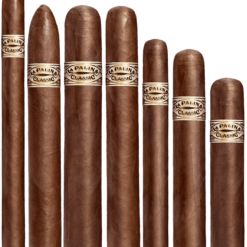La Palina Classic
Showing all 3 results
Step right up, aficionados and novices alike, and feast your eyes on the cigar that combines timeless elegance with modern flair: La Palina Classic. This cigar is more than just a smoke; it’s a sensory journey that marries history with an exquisite flavor profile.
When it comes to flavors, the La Palina Classic is your culinary guide through the tobacco world. Imagine a wheel of complex tastes that spins from earthy cocoa to hints of fruitiness, then slows down with the sumptuous undertones of spices and leather. It’s like a smoky tango where every step is a different note, every twirl a new sensation, until the final crescendo leaves you breathless and longing for more.
History? Oh, this brand has it in spades. La Palina dates back to 1896, founded by Samuel Paley, an immigrant who started as a “lector” in a cigar factory. Initially a tribute to his wife, Goldie, the brand was later resurrected by their grandson, Bill Paley. The Classic line pays homage to that rich heritage, offering a smoke that captures the essence of the original blends. In short, it’s an old soul in a new suit, elegantly contemporary while deeply rooted in tradition.
But what’s that? You want some sizzle with that steak? You’re in luck! La Palina cigars have often been the uncredited stars of Hollywood scenes—adding depth to characters and ambience to settings. Plus, the brand consistently wins hearts and ratings in cigar publications, cementing its place in the aficionado hall of fame.
So whether you’re looking to start your cigar journey or enrich your existing palate, the La Palina Classic offers you a ticket to a world where the past is always present, each puff is a chapter, and the story is far from over. Grab yours and become part of the legacy.

